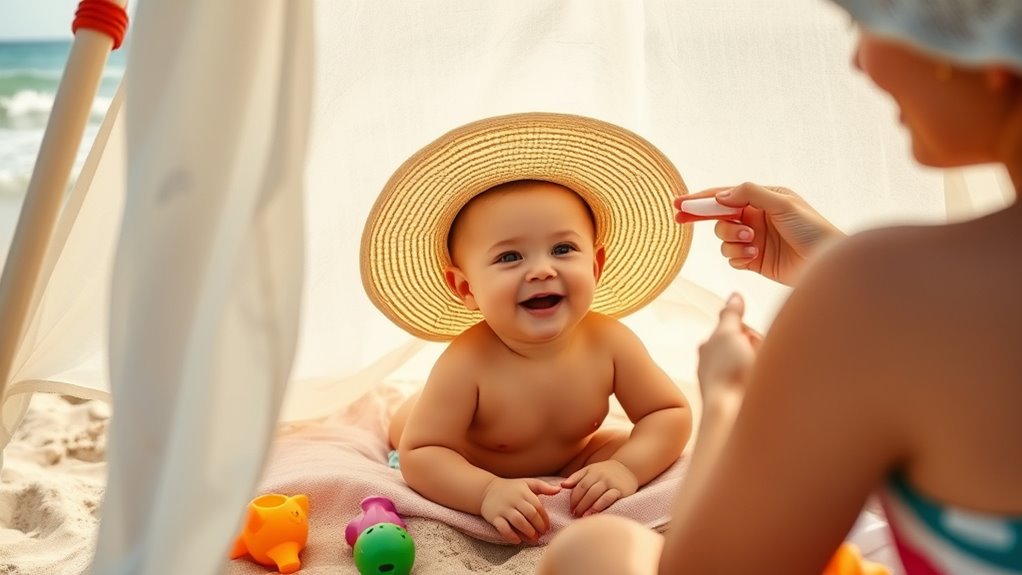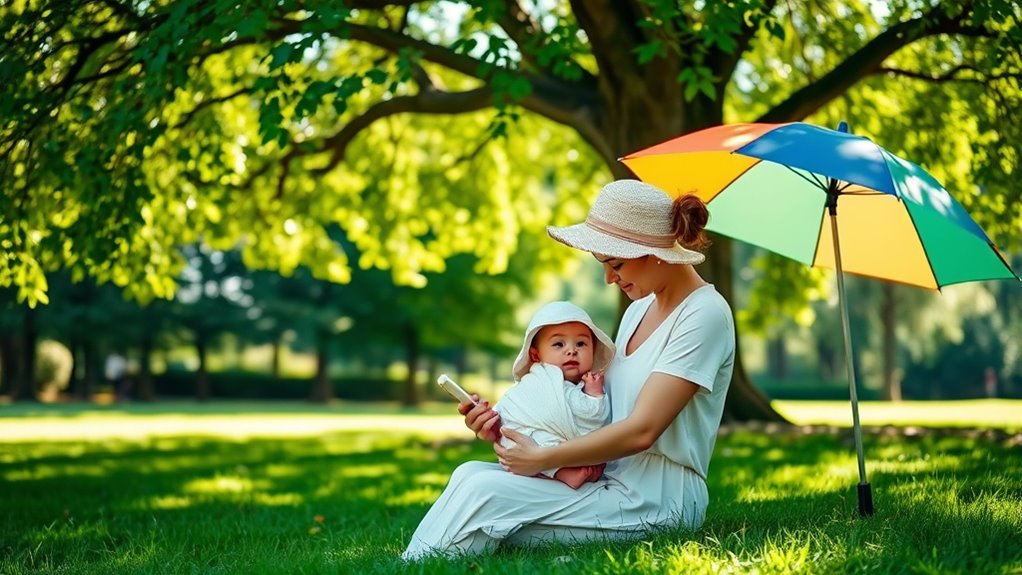To safely expose your baby to sunlight, keep infants under six months in the shade and dress them in lightweight, long-sleeved clothing and a wide-brimmed hat. For babies aged 6-12 months, apply broad-spectrum sunscreen with at least SPF 30. Just 5 to 30 minutes of sunlight twice a week helps with vitamin D. Avoid peak hours between 10 AM and 4 PM. Discover more about essential sun safety strategies to keep your little one protected!
Key Takeaways
- Infants under six months should avoid direct sunlight entirely; keep them in the shade.
- For babies aged 6-12 months, apply broad-spectrum sunscreen with SPF 30 or higher.
- Limit sun exposure during peak hours from 10 AM to 4 PM.
- Ensure infants get 5 to 30 minutes of sunlight twice a week for vitamin D.
- Dress babies in lightweight, long-sleeved clothing and wide-brimmed hats for added protection.
Understanding Sun Safety for Infants

When it comes to sun safety for infants, understanding their unique vulnerabilities is essential. Babies' skin is delicate, making them particularly susceptible to UV radiation. Early detection of skin damage is crucial, as skin changes can indicate potential issues. It is important to note that all skin types require sun protection, including infants. Regular health checks for signs of illness or injury are also important, as they can help monitor your baby's overall well-being.
For the first six months, you should avoid direct sunlight entirely. After that, sun protection methods become vital. Dress your baby in lightweight clothing that covers their arms and legs, and don't forget a wide-brimmed hat to shield their sensitive neck and ears. Additionally, emotional dysregulation can affect how infants react to environmental stressors, including heat and sun exposure.
During peak UV hours, between 10 AM and 4 PM, keep them shaded to minimize exposure. If you must use sunscreen, opt for a broad-spectrum formula with at least SPF 30, but reserve it as a last resort after other protective measures. Additionally, be aware that infants are more vulnerable to the harmful effects of UV radiation compared to older children and adults. Always introduce new products, like sunscreen, gradually to monitor for any adverse reactions.
Key Sun Protection Strategies for Babies

To protect your baby from harmful UV rays, it's important to adopt effective sun safety strategies early on. For infants under 6 months, avoid direct sunlight completely. For those aged 6-12 months, use broad-spectrum sunscreen with at least SPF 30 on exposed skin, while testing for allergies first. During peak sun hours (10 AM to 4 PM), keep your baby in the shade and dress them in lightweight, long-sleeved clothing and wide-brimmed hats for extra skin protection. Additionally, always ensure that the sunscreen is suitable for sensitive skin, as many essential oils can cause skin irritation if not properly diluted. Newborns typically sleep 14-17 hours a day, so plan outdoor activities around their rest schedule. It's also essential to regularly update plans regarding sun safety as your child's age and skin sensitivity change. Furthermore, overexposure to the sun in early childhood may increase the risk of skin cancer later in life. Implementing these strategies can help ensure that your baby enjoys optimal air quality during outdoor activities, enhancing their overall well-being.
| Strategy | Description |
|---|---|
| Avoid Direct Sun | Keep infants under 6 months in the shade |
| Use Clothing | Lightweight, long-sleeved outfits |
| Apply Sunscreen | For babies 6-12 months, SPF 30+ |
| Seek Shade | Stay out of direct sunlight |
| Instill Habits | Encourage sun safety from a young age |
Sunscreen Guidelines for 6 to 12 Months

When your baby is between 6 to 12 months, choosing the right sunscreen is vital for their delicate skin.
You'll want to apply it correctly and remember to reapply it every couple of hours, especially after swimming or sweating.
Let's go over how to guarantee your little one stays protected while enjoying the sun.
Safe Sunscreen Selection
Selecting a safe sunscreen for your baby, especially between 6 and 12 months, is essential for protecting their delicate skin from harmful UV rays.
Here are some guidelines to help you choose wisely:
- Look for broad-spectrum protection with SPF 30 or higher.
- Conduct a patch test on the inside of the wrist to check for allergic reactions.
- Opt for physical sunscreen filters like zinc oxide or titanium dioxide to minimize reactions on sensitive skin.
- Apply sunscreen at least 30 minutes before sun exposure.
- Reapply every two hours, or immediately after swimming or sweating.
Application Techniques
Applying sunscreen correctly is essential for protecting your baby's sensitive skin from harmful UV rays. For babies aged 6 to 12 months, use a broad-spectrum sunscreen with at least SPF 30. Remember to apply sunscreen 15-30 minutes before sun exposure, focusing on exposed areas like the face, hands, and feet. Always conduct a patch test on a small area of their skin first. With the right application techniques, you can guarantee effective sun protection for your little one.
| Important Tips | Details |
|---|---|
| Sunscreen Type | Broad-spectrum, SPF 30+ |
| Application Timing | 15-30 minutes before exposure |
| Patch Test | Test on inside of wrist |
| Exposed Areas | Face, hands, and feet |
| Clothing Coverage | Use clothing for extra cover |
Reapplication Frequency
To guarantee your baby's delicate skin remains protected from harmful UV rays, you'll need to reapply sunscreen regularly.
Here are some essential tips to keep in mind:
- Use broad-spectrum sunscreen with at least SPF 30.
- Apply sunscreen at least 30 minutes before sun exposure.
- Reapply every two hours, or immediately after swimming or sweating.
- Conduct a patch test to check for allergic reactions.
- Incorporate sunscreen into a broader sun protection strategy.
Safeguarding Toddlers From UV Exposure

While enjoying outdoor playtime, it's crucial to keep toddlers safe from harmful UV exposure. Safeguarding your little ones means keeping them out of direct sunlight during peak hours, specifically between 10 AM and 4 PM.
Dress them in long-sleeved, unbleached cotton clothing and wide-brimmed hats to enhance their skin protection. Don't forget to apply broad-spectrum sunscreen with at least SPF 30, reapplying every two hours or after swimming or sweating.
Educating both toddlers and caregivers about sun protection helps instill good habits and reduces the risk of painful sunburn.
Always consider shade availability during outdoor activities, as UV rays can reflect and scatter, putting your babies at risk even in partial sunlight.
Prioritize their safety!
Importance of Vitamin D and Sun Exposure

Sun exposure plays a significant role in your baby's vitamin D levels, which are essential for their bone and muscle health. Typically, infants only need about 5 to 30 minutes of sunlight twice a week to maintain adequate levels.
However, consider these important points:
- Infants with darker skin may require more sun exposure for vitamin D synthesis due to melanin.
- Extended sun exposure without protection can lead to sunburn, negating the benefits of UV rays.
- Dietary sources or supplements may be necessary if sun exposure is limited.
- Regularly consult your healthcare provider if you have concerns about your baby's vitamin D levels.
- Always prioritize sun protection to guarantee your baby's safety while benefiting from the sun.
Resources for Sun Safety Education and Support

You can find a wealth of educational materials from organizations like The Skin Cancer Foundation that highlight the importance of sun safety for your little ones.
Accessing expert guidance from medical specialists can also help you understand Vitamin D's benefits while ensuring your child stays protected.
Local clinics and community workshops offer additional resources to support your family's sun safety practices.
Educational Materials Availability
Accessing educational materials on sun safety is essential for parents and caregivers looking to protect their little ones from harmful UV exposure. Here are some valuable resources to evaluate:
- Skin Cancer Foundation's tailored materials for parents
- Ultraviolet Radiation report detailing risks and strategies
- Pediatricians and dermatologists for personalized advice
- Local sun safety programs and clinics for skin assessments
- SunSmart app for real-time UV level monitoring
Utilizing these resources helps you make informed decisions about skin protection for babies and children.
Look for sun-protective clothing with a high Ultraviolet Protection Factor (UPF) and implement effective sun safety strategies.
Experts report that being proactive about education can greatly reduce the risks associated with UV exposure.
Expert Guidance Access
While maneuvering through the complexities of sun safety, expert guidance can be invaluable for parents seeking to protect their babies from harmful UV exposure.
Resources like The Skin Cancer Foundation offer educational materials that emphasize skin protection for all skin types, including children of color. You can consult healthcare professionals to address concerns about vitamin D levels while ensuring effective sun safety measures.
The Ultraviolet Radiation report highlights the vulnerability of young skin to UV rays, reinforcing the need for proactive strategies, such as applying sunscreen and choosing clothing with a high UPF rating.
Local dermatology clinics often provide specialized care and programs focused on skin health, helping you navigate the risks associated with sun exposure and skin cancer.
Frequently Asked Questions
At What Age Should a Baby Be Exposed to Sunlight?
You should avoid exposing infants under 6 months to direct sunlight, as their skin is too delicate.
Once your baby reaches 6 months, you can introduce limited sun exposure.
Make sure to apply broad-spectrum sunscreen with at least SPF 30 on areas not covered by clothing.
Schedule outdoor activities during early morning or late afternoon to minimize UV exposure, and always seek shade while using protective clothing, hats, and sunglasses.
How Long Do Babies Need to Be Exposed to Sunlight for Vitamin D?
Sunshine supports strong skeletons! Babies need about 5 to 30 minutes of sunlight exposure twice a week for sufficient vitamin D.
However, if your baby's under six months, it's best to keep them in the shade since their skin's so sensitive.
For those over six months, short, shaded sessions are ideal.
Remember, darker-skinned infants might need a little longer in the sun.
Always balance benefits with protective precautions to prevent sunburn.
What Are the Guidelines for Sun Exposure?
When it comes to sun exposure for babies, you need to be cautious.
For infants under 6 months, avoid direct sunlight completely.
If your baby's between 6 to 12 months, apply broad-spectrum sunscreen with at least SPF 30, but test for allergies first.
Schedule outdoor activities during early mornings or late afternoons to minimize UV exposure.
Also, dress them in lightweight, long-sleeved clothing, and use hats and stroller shades for extra protection.
Is It Good for Babies to Be Out in the Sun?
Sunshine's sweet, but safety's super essential for your baby!
It's not always good for little ones to bask in the sun. For babies under 6 months, staying out of direct sunlight is best to protect their fragile skin.
If they're older, short bursts of sun during early mornings or late afternoons can help with vitamin D while minimizing risks.
Always seek shade during peak hours, and prioritize sun protection.
Your baby's skin deserves the best!
Conclusion
In conclusion, sun safety for your little one is vital. Shielding sensitive skin, selecting the right sunscreen, and savoring safe sun exposure are key steps in protecting your baby. Soak up the sun wisely while ensuring your child gets that essential vitamin D. Remember, a little precaution goes a long way in promoting playful, protected outdoor adventures. Stay savvy, and keep those sun safety strategies shining bright for your precious bundle of joy!









